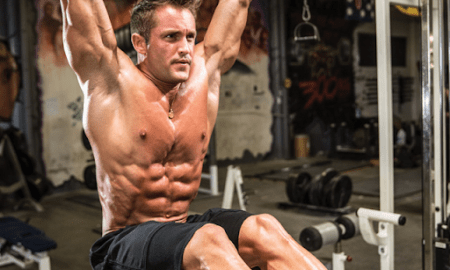Q: If you were me—ectomorph, 17 years old, 5’3’ and 112 pounds with one upper ab showing when flexed—what routine would you do? Upper-body/lower-body split? How about diet? I count calories, eat everything and just maintain weight, so I started bumping up the calories and supplementing with creatine. Still, I’m confused. Should I keep doing a five-day-split routine or something else? I tried a three-day split for a couple of months, so I’m also confused on whether I should train for strength or hypertrophy. What would I benefit from the most?
A: You sound as if you definitely want to add more size and weight to your physique. I can relate to your situation because I was pretty skinny when I started training; at 14 years old I was 135 pounds at 5’8”, and my greatest challenge during my first five or six years of training was to gain weight and get bigger.
Remember that your body grows when you’re resting, so I recommend that you train only three or four days a week at the most. Always take a complete day of rest between workouts so you can recuperate fully and grow.
I think the best way to split up your workouts would be to divide the muscle groups so you train half your body at one workout and the other half at the next workout. I suggest the push/pull split, which is chest, deltoids and triceps at the first workout and back and biceps plus legs at the second, or you can train chest, back and deltoids at the first workout and legs and arms at the second.
Focus on using only the basic exercises with barbells and dumbbells. Exercises such as squats, deadlifts, barbell rows, bench presses, incline presses, dips, chins, overhead presses and shrugs are great for building mass and strength. They use several muscle groups, so you can add more resistance and demand more from your muscle tissues.
Try to keep your total sets in any workout to 25 or fewer. If you do too many sets, you limit the amount of energy you can put into each potentially growth-producing set.
You asked whether you should do more of a strength-building workout or train for muscle growth. I believe the best repetition range for building mass is six to eight. That will build thicker muscle fibers while forcing more blood into the muscle tissues. The combination of heavy weight with a good pump is the key to building bigger, stronger muscles.
Although the six-to-eight-rep range is the best for building mass, you also have to gradually get stronger, which is best achieved by using resistance heavy enough to limit your reps to three to five per set.
One technique that I used when I was bulking up is to go very heavy on one exercise for each muscle group once per week. For example, when working chest, I would do my normal sets of six to eight reps, but for my last set I’d increase the weight to one that limited me to only three reps. My training partner would then spot me and help me force out another two to three repetitions. That helped build up my strength, and eventually I was using that same heavy weight for six reps on my own.
Here’s an example of how you could design your training program using the push/pull system:
Workout 1
Bench presses 4 x 10, 8, 6, 6
Incline presses 3 x 8, 6, 6
Standing military presses 3 x 10, 8, 6
Upright rows 3 x 8, 6, 6
Barbell shrugs 3 x 10, 8, 6
Close-grip bench presses 3 x 10, 8, 6
Parallel-bar dips 3 x 8, 6, 6
Standing calf raises 4 x 12, 10, 8, 8
Workout 2
Incline situps 2 x max
Incline knee raises 2 x max
Squats 4 x 10, 8, 6, 6
Leg presses 3 x 10, 8, 6
Stiff-legged deadlifts 3 x 10, 8, 6
Wide-grip chins 3 x 10, 8, 6
Barbell rows 3 x 8, 6, 6
Deadlifts 3 x 8, 6, 6
Barbell curls 3 x 10, 8, 6
As for your nutrition program, I think it’s great that you’re counting everything that you’re eating now. If you know exactly how many calories and how much protein, carb and fat you’re taking in, you can make adjustments.
If your weight is staying the same, start increasing both calories and carbohydrates. At 112 pounds, you want to eat around 170 grams of protein (1.5 grams per pound of bodyweight) and 250 to 350 grams of complex carbohydrates—whole-wheat bread, whole-wheat pasta, brown rice, oatmeal, etc. That will give you a little more than 2,000 calories a day. If you ate 60 grams of fats, you’d be eating 2,620 calories. I’m not sure how many you’re eating now, but if you need to eat more, keep increasing the calories and carbs until you start to gain weight.
Many bodybuilders load up on protein when they’re trying to gain weight. Although protein is essential for building muscle, the body can only absorb so much at one time. The rest of your calories should come from carbohydrates and fats.
One rule I followed when I was trying to gain muscular weight was to eat two sources of carbohydrate for each portion of protein at meals. For example, breakfast would consist of a seven-egg omelet with whole-wheat toast and oatmeal. Lunch would typically be lean ground beef with brown rice and whole-wheat bread.
Another trick I used was to eat foods that contained ample amounts of fat. Since fat contains twice as many calories as protein and carb—nine calories for each gram of fat compared to four for each gram of protein and carbohydrate—eating foods that contained fat automatically increased my calories.
I intentionally ate high-protein foods that were also high in fat, such as whole eggs, whole milk, cheeses and beef. Those foods gave me the protein I needed along with lots of calories. The fats in those foods also helped me increase my strength in the gym.
I went through the same process when I was 20 years old. I was training really hard and heavy on the basic exercises four days a week, and I was eating a lot of good bodybuilding food, but it wasn’t enough. I couldn’t gain weight. I kept increasing my calories and carbs until I finally started to gain some weight and got both bigger and stronger. You have to adjust your diet according to your metabolism. It sounds as if your metabolism is very fast, so you have to eat enough to make your body gain weight.
Q: I notice you have a great peak on your biceps. What exercises did you do to develop that?
A: The shape of your biceps is pretty much determined by your genetics, just like the shape of all your muscles. There are, however, biceps exercises that will enhance your peak.
The most famous exercise is concentration curls, but many bodybuilders do them incorrectly. When you do concentration curls seated on a bench with your elbow pressed against your thigh, you can curl more weight, even using your upper body to help get the weight up. If your goal is to create a higher biceps peak, however, you should isolate the biceps.
First of all, stand up and bend over at the waist so your upper body is parallel to the floor. Keeping your upper arm perpendicular to the floor, grab the dumbbell and slowly curl the weight, keeping the arc of the movement in line with your deltoid and upper arm. You don’t want your lower arm to drift out of the groove.
It takes discipline to keep your upper arm stable while you slowly curl and flex the biceps at the top of the movement. The only part of your arm that should move is your forearm. Once you get the movement down, you’ll really notice a difference in the peak of your biceps. Watch the movie “Pumping Iron” and note how Arnold does concentration curls.
Even if you don’t naturally have a peak to your biceps, you can do a lot to create one. Franco Columbu, for example, had short biceps that showed little potential when he started training. After a few years in the gym he’d developed some size and a pretty good peak by working his biceps hard. As Arnold used to say, “Visualize your biceps as a mountain in order to develop a great peak.”
Editor’s note: John Hansen has won the Mr. Natural Olympia and is a two-time Natural Mr. Universe winner. Check out his Web site at www.NaturalOlympia.com, or send questions or comments to him via e-mail at [email protected]. Look for John’s DVD, “Natural Bodybuilding Seminar and Competitions,” along with his book, Natural Bodybuilding, and his training DVD, “Real Muscle,” at his Web site or at Home Gym Warehouse, www.Home-Gym.com. Listen to John’s new radio show, “Natural Bodybuilding Radio,” at www.NaturalBodybuildingRadio.com. You can send written correspondence to John Hansen, P.O. Box 3003, Darien, IL 60561. IM




















You must be logged in to post a comment Login